Deck 6: Series-Parallel Circuits
Question
Question
Question
Question
Question
Question
Question
Question
Question
Question
Question
Question
Question
Question
Question
Question
Question
Question
Question
Question
Question
Question
Question
Question
Question
Question
Question
Question
Question
Question
Question
Question
Question
Question
Question
Question
Question
Question
Question
Question
Question
Question
Question
Question
Question
Question
Question
Question
Question
Question
Question
Question
Question
Question
Question
Question
Question
Question
Question
Question
Question
Question
Question
Question
Question
Question
Question
Question
Question
Question
Question

Unlock Deck
Sign up to unlock the cards in this deck!
Unlock Deck
Unlock Deck
1/71
Play
Full screen (f)
Deck 6: Series-Parallel Circuits
1
Maximum power is achievedW hen the load resistance is approximately two times the source resistance.
False
2
A voltmeter,W hen connected across a component, can be viewed as being a resistor in seriesW ith that component.
False
3
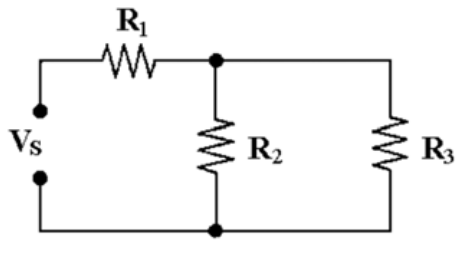
-If R1=4.7 , R2=3.3 and R3=1 in Figure 6-1 , the total resistance equals________
A) 660
B) 5700
C) 4125
D) 5467
5467
4
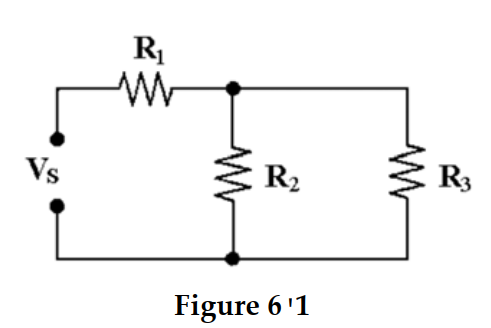
R1 is in series with R3 in Figure 6-1.

Unlock Deck
Unlock for access to all 71 flashcards in this deck.
Unlock Deck
k this deck
5
A series-parallel circuit consists of resistors in both series and parallel.

Unlock Deck
Unlock for access to all 71 flashcards in this deck.
Unlock Deck
k this deck
6

-If VS=20 V, R1=10 , R2=50 and R3=15 in Figure 6-1, PR2 equals________
A) 7.64 mW
B) 2.30 mW
C) 8.63 mW
D) 18.6 mW

Unlock Deck
Unlock for access to all 71 flashcards in this deck.
Unlock Deck
k this deck
7
A bridge circuitʹs resistances must all be of the same value to be in a balanced condition.

Unlock Deck
Unlock for access to all 71 flashcards in this deck.
Unlock Deck
k this deck
8
Thevinizing a circuit creates an equivalent series circuit.

Unlock Deck
Unlock for access to all 71 flashcards in this deck.
Unlock Deck
k this deck
9

R1 is in series with the parallel combination R2 and R3 in Figure 6-1.

Unlock Deck
Unlock for access to all 71 flashcards in this deck.
Unlock Deck
k this deck
10

-In Figure 6-1, R1 is connected in________
A) series with R2
B) parallel with R2
C) parallel with R3
D) series with R3
E) none of the above

Unlock Deck
Unlock for access to all 71 flashcards in this deck.
Unlock Deck
k this deck
11

R1 is in series with the series combination R2 and R3 in Figure 6-1.

Unlock Deck
Unlock for access to all 71 flashcards in this deck.
Unlock Deck
k this deck
12
If two resistors are in parallel, they carry the same current.

Unlock Deck
Unlock for access to all 71 flashcards in this deck.
Unlock Deck
k this deck
13

R2 is in parallel with R3 in Figure 6-1.

Unlock Deck
Unlock for access to all 71 flashcards in this deck.
Unlock Deck
k this deck
14

-If R3 opens in Figure 6-1,VR1_____
A) decreases
B) remains the same
C) decreases to zero
D) increases

Unlock Deck
Unlock for access to all 71 flashcards in this deck.
Unlock Deck
k this deck
15
Two or more resistors connected in series form a circuit known as a voltage divider

Unlock Deck
Unlock for access to all 71 flashcards in this deck.
Unlock Deck
k this deck
16
No problems could occur if a 10 V source and a 20 V sourceW ere connected in parallel.

Unlock Deck
Unlock for access to all 71 flashcards in this deck.
Unlock Deck
k this deck
17
A loaded voltage divider is a series-parallel circuit.

Unlock Deck
Unlock for access to all 71 flashcards in this deck.
Unlock Deck
k this deck
18
The voltage across any open in a series-parallel circuitW ill be the source Voltage.

Unlock Deck
Unlock for access to all 71 flashcards in this deck.
Unlock Deck
k this deck
19

-In Figure 6-1, R2 is connected in______
A) series with R3
B) parallel with R1
C) parallel with R3
D) series with R1

Unlock Deck
Unlock for access to all 71 flashcards in this deck.
Unlock Deck
k this deck
20
If two resistors are in parallel, they drop the same Voltage.

Unlock Deck
Unlock for access to all 71 flashcards in this deck.
Unlock Deck
k this deck
21
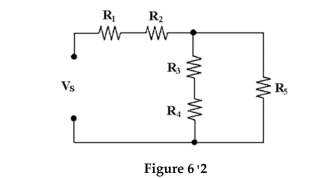
If all resistors equal 4.7
 and VS equals 20 V in Figure 6-2 , what is the value of IR3 ?
and VS equals 20 V in Figure 6-2 , what is the value of IR3 ?A) 1.06 mA
B) 0.53 mA
C) 11.99 mA
D) 12.5 mA

Unlock Deck
Unlock for access to all 71 flashcards in this deck.
Unlock Deck
k this deck
22
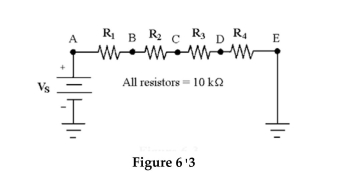
If VR4=10 V in Figure 6-3 , what is the value of VAD ?
A) 10 V
B) 30 V
C) 40 V
D) 20 V

Unlock Deck
Unlock for access to all 71 flashcards in this deck.
Unlock Deck
k this deck
23

-If VS=25 V, R1=10 , R2=15 and R3=50 in Figure 6-1 , IT equals_______
A) 1.16 mA
B) 1.58 mA
C) 2.17 mA
D) 2.5 mA

Unlock Deck
Unlock for access to all 71 flashcards in this deck.
Unlock Deck
k this deck
24

-If R4 shorts in Figure 6-2, VR5 _________
A) decreases to zero
B) decreases
C) increases
D) remains the same

Unlock Deck
Unlock for access to all 71 flashcards in this deck.
Unlock Deck
k this deck
25

If VS=12 V in Figure 6-3 , what is the value of VEB if R3 shorts?
A) -3 V
B) 8 V
C) 6 V
D) -8 V

Unlock Deck
Unlock for access to all 71 flashcards in this deck.
Unlock Deck
k this deck
26

If a 10
 resistor is placed in parallel with R4 in Figure 6-3, how will VR4 change?
resistor is placed in parallel with R4 in Figure 6-3, how will VR4 change?A) VR4 will remain the same.
B) VR4 will decrease.
C) VV4 will increase.
D) VR4 will change to 4 volts.

Unlock Deck
Unlock for access to all 71 flashcards in this deck.
Unlock Deck
k this deck
27

What is the resistance between points B and E in Figure 6-3 ?
A) 30

B) 20

C) 40

D) 10


Unlock Deck
Unlock for access to all 71 flashcards in this deck.
Unlock Deck
k this deck
28

-If R1=50 , R2=10 , R3=10 , R4=50 and R5=10 in Figure 6-2 , what is the value of RT?
A) 8.57
B) 68.6
C) 85.7
D) 130

Unlock Deck
Unlock for access to all 71 flashcards in this deck.
Unlock Deck
k this deck
29

-If R1 shorts in Figure 6-2, VR4______
A) equals VR2
B) remains the same
C) increases
D) decreases

Unlock Deck
Unlock for access to all 71 flashcards in this deck.
Unlock Deck
k this deck
30

-If R3 shorts in Figure 6-2, VR5 ______
A) remains the same
B) decreases
C) increases

Unlock Deck
Unlock for access to all 71 flashcards in this deck.
Unlock Deck
k this deck
31

-If R1=10 , R2=15 and R3=50 in Figure 6-1, RT equals_____
A) 11.5
B) 10
C) 21.5
D) 9.5

Unlock Deck
Unlock for access to all 71 flashcards in this deck.
Unlock Deck
k this deck
32

If VS=15 V and every resistor equals 2.2
 in Figure 6-2, what is the value of IR4 ?
in Figure 6-2, what is the value of IR4 ?A) 5.11 mA
B) 2.55 mA
C) 0.85 mA
D) 0.42 mA

Unlock Deck
Unlock for access to all 71 flashcards in this deck.
Unlock Deck
k this deck
33

-If R1=4.7 , R2=3.3 , R3=1 and VS=50 V in Figure 6-1,IT equals_____
A) 75.7 mA
B) 9.15 mA
C) 12.1 mA
D) 8.8 mA

Unlock Deck
Unlock for access to all 71 flashcards in this deck.
Unlock Deck
k this deck
34

If all of the resistors in Figure 6-2 are 4.7
 , what is the value of RT?
, what is the value of RT?A) 12.5

B) 4.7

C) 18.8

D) 9.4


Unlock Deck
Unlock for access to all 71 flashcards in this deck.
Unlock Deck
k this deck
35

If VS=15 V and every resistor equals 2.2
 in Figure 6-2, what is the value of IR4 ?
in Figure 6-2, what is the value of IR4 ?A) 5.11 mA
B) 2.55 mA
C) 0.85 mA
D) 0.42 mA

Unlock Deck
Unlock for access to all 71 flashcards in this deck.
Unlock Deck
k this deck
36

-In Figure 6-2, R3 and R4 are connected in________
A) series with each other and R5
B) series with each other
C) series with each other and R1 and R2
D) parallel with R1 and R2

Unlock Deck
Unlock for access to all 71 flashcards in this deck.
Unlock Deck
k this deck
37

If VS=22 V in Figure 6-3, what is the is the value of VDB ?
A) -11 V
B) -22 V
C) 11 V
D) 5.5 V

Unlock Deck
Unlock for access to all 71 flashcards in this deck.
Unlock Deck
k this deck
38

If every resistor in Figure 6-2 equals 2.2
 , what is the value of RT ?
, what is the value of RT ?A) 2.2

B) 5.5

C) 5.87

D) 4.4


Unlock Deck
Unlock for access to all 71 flashcards in this deck.
Unlock Deck
k this deck
39

-In Figure 6-2, R3 and R4 are connected in_____________
A) series with R2
B) parallel with each other
C) series with each other and in parallel with R5
D) series with R5

Unlock Deck
Unlock for access to all 71 flashcards in this deck.
Unlock Deck
k this deck
40

What is the resistance between points A and D in Figure 6-3?
A) 30

B) 10

C) 20

D) 40


Unlock Deck
Unlock for access to all 71 flashcards in this deck.
Unlock Deck
k this deck
41

If the current is 1.2 mA in Figure 6-3 , what is the value of PT ?
A) 576 mW
B) 5.76 mW
C) 0.576 mW
D) 57.6 mW

Unlock Deck
Unlock for access to all 71 flashcards in this deck.
Unlock Deck
k this deck
42
If four parallel 10  resistors are connected in series with a single 20
resistors are connected in series with a single 20  resistor and one of the parallel resistors opens, how does the voltage across the other parallel resistors change?
resistor and one of the parallel resistors opens, how does the voltage across the other parallel resistors change?
A) It increases.
B) It remains the same.
C) It decreases.
 resistors are connected in series with a single 20
resistors are connected in series with a single 20  resistor and one of the parallel resistors opens, how does the voltage across the other parallel resistors change?
resistor and one of the parallel resistors opens, how does the voltage across the other parallel resistors change?A) It increases.
B) It remains the same.
C) It decreases.

Unlock Deck
Unlock for access to all 71 flashcards in this deck.
Unlock Deck
k this deck
43

If a fifth 10
 resistor is connected in series in Figure 6-3, how does VR4 change?
resistor is connected in series in Figure 6-3, how does VR4 change?A) VR4 decreases.
B) VR4 remains the same.
C) VR4 increases to 10 V.
D) VR4 increases.

Unlock Deck
Unlock for access to all 71 flashcards in this deck.
Unlock Deck
k this deck
44
One Ohm's law formula  can be used to solve for total power in:
can be used to solve for total power in:
A) series-parallel circuits.
B) series circuits.
C) parallel circuits.
D) all of these.
 can be used to solve for total power in:
can be used to solve for total power in:A) series-parallel circuits.
B) series circuits.
C) parallel circuits.
D) all of these.

Unlock Deck
Unlock for access to all 71 flashcards in this deck.
Unlock Deck
k this deck
45
If four parallel 10 resistors are in series with a single 20 resistor and one of the parallel resistors shorts, the voltage across the other parallel resistors________
A) decreases
B) remains the same
C) increases
A) decreases
B) remains the same
C) increases

Unlock Deck
Unlock for access to all 71 flashcards in this deck.
Unlock Deck
k this deck
46
In solving series-parallel circuits using Ohmʹs law, first solve for:
A)the series resistance.
B)the parallel current.
C)the series current.
D)the parallel resistance.
A)the series resistance.
B)the parallel current.
C)the series current.
D)the parallel resistance.

Unlock Deck
Unlock for access to all 71 flashcards in this deck.
Unlock Deck
k this deck
47
The parallel combination of a 330 resistor and a 470
resistor and a 470 resistor is connected in series with the parallel combination of four 1 resistors. If a 100 V source is connected across the circuit, then which resistor carries the most current?
resistor is connected in series with the parallel combination of four 1 resistors. If a 100 V source is connected across the circuit, then which resistor carries the most current?
A) 470
B) 330
C) 1
 resistor and a 470
resistor and a 470 resistor is connected in series with the parallel combination of four 1 resistors. If a 100 V source is connected across the circuit, then which resistor carries the most current?
resistor is connected in series with the parallel combination of four 1 resistors. If a 100 V source is connected across the circuit, then which resistor carries the most current?A) 470

B) 330
C) 1

Unlock Deck
Unlock for access to all 71 flashcards in this deck.
Unlock Deck
k this deck
48
In the series portion of series-parallel circuits, the total resistance is:
A)less than any one resistance.
B)equal to the largest resistance.
C)less than the largest resistance.
D)greater than the largest resistance.
A)less than any one resistance.
B)equal to the largest resistance.
C)less than the largest resistance.
D)greater than the largest resistance.

Unlock Deck
Unlock for access to all 71 flashcards in this deck.
Unlock Deck
k this deck
49

If the current is 12 mA in Figure 6-3, what is the value of VEB ?
A) 240 V
B) -360 V
C) -240 V
D) 360 V

Unlock Deck
Unlock for access to all 71 flashcards in this deck.
Unlock Deck
k this deck
50

If VS=50 V in Figure 6-3 , what is the value of VCA ?
A) 25 V
B) -25 V
C) -5 V
D) 5 V

Unlock Deck
Unlock for access to all 71 flashcards in this deck.
Unlock Deck
k this deck
51

If VR1=15 V in Figure 6-3 , what is the value of VBD ?
A) -60 V
B) 60 V
C) 30 V
D) -30 V

Unlock Deck
Unlock for access to all 71 flashcards in this deck.
Unlock Deck
k this deck
52
If a voltage divider consists of two 10  resistors, which one of these load resistors will change the output voltage the most?
resistors, which one of these load resistors will change the output voltage the most?
A) 20
B) 1
C) 100
D) 10
 resistors, which one of these load resistors will change the output voltage the most?
resistors, which one of these load resistors will change the output voltage the most?A) 20

B) 1

C) 100

D) 10


Unlock Deck
Unlock for access to all 71 flashcards in this deck.
Unlock Deck
k this deck
53
In solving series-parallel circuits using Ohmʹs law, first solve for:
A)ET.
B)IT.
C)RT.
D)any of these, it doesnʹt matter.
A)ET.
B)IT.
C)RT.
D)any of these, it doesnʹt matter.

Unlock Deck
Unlock for access to all 71 flashcards in this deck.
Unlock Deck
k this deck
54
Two series 1  resistors are connected in parallel with a 2.2
resistors are connected in parallel with a 2.2  resistor. If the voltage across one of the 1
resistor. If the voltage across one of the 1  resistors is 6 V, what is the voltage across the 2.2
resistors is 6 V, what is the voltage across the 2.2  resistor?
resistor?
A) 3 V
B) 12 V
C) 6 V
D) 13.2 V
 resistors are connected in parallel with a 2.2
resistors are connected in parallel with a 2.2  resistor. If the voltage across one of the 1
resistor. If the voltage across one of the 1  resistors is 6 V, what is the voltage across the 2.2
resistors is 6 V, what is the voltage across the 2.2  resistor?
resistor?A) 3 V
B) 12 V
C) 6 V
D) 13.2 V

Unlock Deck
Unlock for access to all 71 flashcards in this deck.
Unlock Deck
k this deck
55
The parallel combination of a 330 resistor and a 470
resistor and a 470
resistor is connected in series with the parallel combination of four 1
resistors. If a 100 V source is connected across the circuit, then which resistor drops the most voltage?
A) 470
B) 330
C) 1
 resistor and a 470
resistor and a 470 resistor is connected in series with the parallel combination of four 1
resistors. If a 100 V source is connected across the circuit, then which resistor drops the most voltage?
A) 470

B) 330
C) 1

Unlock Deck
Unlock for access to all 71 flashcards in this deck.
Unlock Deck
k this deck
56
In solving series-parallel circuits, the last and easiest to solve for is:
A)RT.
B)PT.
C)IT.
D)ET.
A)RT.
B)PT.
C)IT.
D)ET.

Unlock Deck
Unlock for access to all 71 flashcards in this deck.
Unlock Deck
k this deck
57

If VR3=17 V in Figure 6-3 , what is the value of P1 ?
A) 2.89 W
B) 1.7 mW
C) 28.9 mW
D) 17 mW

Unlock Deck
Unlock for access to all 71 flashcards in this deck.
Unlock Deck
k this deck
58

If VS=40 V and R3 opens in Figure 6-3 , what is the value of VR3 ?
A) 40 V
B) 30 V
C) 0 V
D) 20 V
E) 10 V

Unlock Deck
Unlock for access to all 71 flashcards in this deck.
Unlock Deck
k this deck
59
Power in a series-parallel resistor circuit is dissipated as:
A)current flow.
B)voltage loss.
C)resistance change.
D)heat.
A)current flow.
B)voltage loss.
C)resistance change.
D)heat.

Unlock Deck
Unlock for access to all 71 flashcards in this deck.
Unlock Deck
k this deck
60
In a two-source circuit, one source alone produces 10 mA through a branch. If the other source alone produces 8 mA in the opposite direction through the same branch,W hat is the total current through the branch?
A)8 mA
B)18 mA
C)10 mA
D)2 mA
A)8 mA
B)18 mA
C)10 mA
D)2 mA

Unlock Deck
Unlock for access to all 71 flashcards in this deck.
Unlock Deck
k this deck
61
According to the maximum power transfer theorem, maximum power is delivered to any load when the load resistance is:
A)larger than source resistance.
B)at least twice or more than the source resistance.
C)less than one-half of the source resistance.
D)exactly equal to the source resistance.
A)larger than source resistance.
B)at least twice or more than the source resistance.
C)less than one-half of the source resistance.
D)exactly equal to the source resistance.

Unlock Deck
Unlock for access to all 71 flashcards in this deck.
Unlock Deck
k this deck
62
Theveninʹs theorem provides a method for:
A)designing complex series-parallel circuits.
B)simplifying complex series-parallel circuits.
C)building complex series-parallel circuits.
D)all of these.
A)designing complex series-parallel circuits.
B)simplifying complex series-parallel circuits.
C)building complex series-parallel circuits.
D)all of these.

Unlock Deck
Unlock for access to all 71 flashcards in this deck.
Unlock Deck
k this deck
63
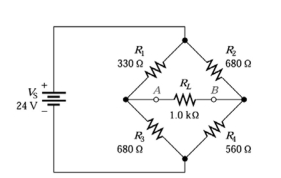
-Refer to Figure 6-4. If R1 is changed to 500 , the Thevenin resistance and voltage would be:
A) 595 and 3 V .
B) 1 k and 807 mV .
C) 595 and 807 mV .
D) 1 k and 3 V .

Unlock Deck
Unlock for access to all 71 flashcards in this deck.
Unlock Deck
k this deck
64
The super position theorem provides a method for:
A)designing complex series-parallel circuits.
B)building complex series-parallel circuits.
C)analyzing complex series-parallel circuits.
D)all of these.
A)designing complex series-parallel circuits.
B)building complex series-parallel circuits.
C)analyzing complex series-parallel circuits.
D)all of these.

Unlock Deck
Unlock for access to all 71 flashcards in this deck.
Unlock Deck
k this deck
65
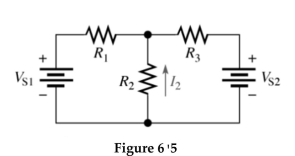
Refer to Figure 6-5. Determine the amount of current flow through R2 with the following component parameters. VS1=10 V, VS2=3 V, R1=2 k, R2=3k , and R3=700
A) 5.3 mA
B) 1 mA
C) 1.37 mA
D) 0 A

Unlock Deck
Unlock for access to all 71 flashcards in this deck.
Unlock Deck
k this deck
66
TheW heatstone bridge circuit isW idely used to measure:
A)precise resistances.
B)accurate currents.
C)exactVoltages.
D)all of these.
A)precise resistances.
B)accurate currents.
C)exactVoltages.
D)all of these.

Unlock Deck
Unlock for access to all 71 flashcards in this deck.
Unlock Deck
k this deck
67
In the parallel portion of series-parallel circuits, the total resistance is:
A)greater than the largest resistance.
B)less than any one resistance.
C)equal to the smallest resistance.
D)less than the smallest resistance.
A)greater than the largest resistance.
B)less than any one resistance.
C)equal to the smallest resistance.
D)less than the smallest resistance.

Unlock Deck
Unlock for access to all 71 flashcards in this deck.
Unlock Deck
k this deck
68

-Refer to Figure 6-4. What approximate R1 resistor value would it take to balance this bridge circuit?
A) 825

B) 680
C) 560
D) 330


Unlock Deck
Unlock for access to all 71 flashcards in this deck.
Unlock Deck
k this deck
69

-Refer to Figure 6-4.W ith circuit balanced there is:
A)Cannot be determined wIthout detailed analysis.
B)maximum current flow through the load.
C)no current flow through the total circuit.
D)no current through the load.

Unlock Deck
Unlock for access to all 71 flashcards in this deck.
Unlock Deck
k this deck
70
The difference between a balanced and an unbalancedW heatstone bridge is measured by:
A)an ammeter.
B)a voltmeter.
C)a galvanometer.
D)an ohmmeter.
A)an ammeter.
B)a voltmeter.
C)a galvanometer.
D)an ohmmeter.

Unlock Deck
Unlock for access to all 71 flashcards in this deck.
Unlock Deck
k this deck
71

Refer to Figure 6-5. If all of the resistors of this circuit are 5
 and VS1 and VS2 are 10 V but opposing polarities, what would be the current flow through R2 ?
and VS1 and VS2 are 10 V but opposing polarities, what would be the current flow through R2 ?A) 2.66 mA
B) 13.33 mA
C) 0 A
D) 1.33 mA

Unlock Deck
Unlock for access to all 71 flashcards in this deck.
Unlock Deck
k this deck



